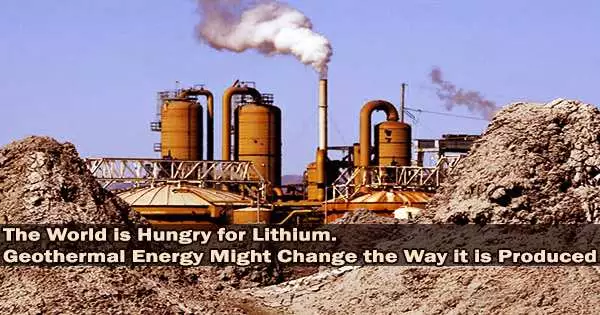The stunning coastline, lush landscape, and delicious seafood are all well-known features of the southwest of England. If everything goes according to plan, lithium extraction might be a new weapon in the region’s arsenal within the next several years.
An industry that could one day produce both renewable energy and a local source of lithium is being developed in the county of Cornwall by utilizing the region’s natural resources.
Lithium is essential to electric vehicles and battery storage, two technologies with a significant role to play in the planet’s transition to a low and zero emission future, in addition to its use in cell phones, computers, tablets, and a variety of other gadgets ubiquitous with modern living.
Examples of how this nascent sector could progress over the next few years include Geothermal Engineering Ltd, a company based near the Cornish town of Redruth specializing in the development and operation of geothermal projects.
GEL is working on a trial project focusing on the extraction of lithium from geothermal waters in addition to its anticipated renewable energy operations. It’s a partnership with Cornish Lithium, another business, through a joint venture known as GeoCubed.
“The aim is to demonstrate that lithium hydroxide, a key component of lithium-ion batteries used in electric vehicles, can be produced in Cornwall from naturally occurring geothermal water with a net zero carbon footprint,” GEL says.
The project in Cornwall is focused on direct lithium extraction, or DLE. According to the U.S. Department of Energy’s National Renewable Energy Laboratory, the technologies behind DLE “can be broadly grouped into three main categories: adsorption using porous materials that enable lithium bonding, ion exchange, and solvent extraction.”
While there is excitement about its potential, the NREL cautions it “remains a challenging task” to scale up the above methods to what it calls “full production capability.”
“For example, developing a solid material that bonds with just lithium is a huge challenge in geothermal brine that contains many minerals and metals,” it says.
‘Irreplaceable’ for a green transition
Concerns about sustainability and ESG are growing, which is why initiatives like the one in Cornwall are taking place at this moment. Another concern is the safety of global supply networks, particularly in light of the fact that Chile, China, Australia, and Argentina now produce the vast bulk of the world’s lithium.
In light of this, commercializing less expensive, more accessible, and local methods of obtaining lithium could be crucial moving forward.
Plans to boost the number of electric vehicles on our roadways are being laid out by major economies and automakers. At the same time, there is a continued push to increase the capacity of renewable energy sources.
Julia Poliscanova is senior director for e-mobility at Transport & Environment, a campaign group headquartered in Brussels. Speaking to CNBC, she described lithium as being “irreplaceable for all of our green transitions.”
When it came to the sustainable sourcing of lithium and other materials, Poliscanova said that, “mid to long term, it’s clear that the vast majority of it has to come from circular business models, most notably recycling.”
She noted how there would be “really immense growth and demand” over the next few decades. This would require, in the short to medium term, new extraction techniques.
Expanding on her point, Poliscanova said the majority of lithium that will be in use in 2030 had not been extracted yet.
“That’s where geothermal lithium comes in,” she said, “because the new lithium, the new resources we … need, it has to be sustainably mined and has to be with the lowest impact on the environment and our communities.”
‘How do we get it out?’
GeoCubed’s £4 million ($5.46 million) pilot plant will focus on a range of direct lithium extraction technologies. The overall objective is to eventually develop a commercial plant at GEL’s United Downs Deep Geothermal Power Project.
In an interview with CNBC, Ryan Law, GEL’s founder and managing director, outlined the opportunity his business was looking to capitalize on. Beneath its surface, Cornwall is home to a lot of granite rock which in turn has a high lithium content, Law explained.
“The combination of the granite rock being rich in lithium and hot water hot water can absorb more lithium means that the water that we bring to the surface at United Downs to drive our power plant has a very high lithium content,” he said.
“The next step is: how do we get it out?” Law went on to say. “And that’s what we’ve been looking at in conjunction with a number of partners.”
Changing times
GEL is one of several firms looking to develop facilities focused on direct lithium extraction. Alongside GeoCubed, Cornish Lithium is also working on a number of other projects.
Elsewhere, in April 2021, Australia-listed Vulcan Energy Resources said its direct lithium extraction pilot plant, located in Germany’s Upper Rhine Valley, had started operations.
In the U.S. in November, a firm called Controlled Thermal Resources announced that its drilling program at the Hell’s Kitchen Lithium and Power project in California had begun.
At the time, CEO Rod Colwell said the company was “on schedule to deliver the project’s first 50MW of baseload renewable power in late 2023 and an estimated 20,000 tonnes of lithium hydroxide in 2024.”
The Hell’s Kitchen project is attracting attention from some major players. Last summer, General Motors said it had “agreed to form a strategic investment and commercial collaboration with Controlled Thermal Resources to secure local and low-cost lithium.”
“As the first investor, GM will have first rights on lithium produced by the first stage of the Hell’s Kitchen project, including an option for a multi-year relationship,” the carmaker later added.
Sea change
The aforementioned advances are in varying phases of research, but if they are able to produce in large quantities, it could cause a fundamental shift in how lithium is extracted.
According to the NREL, the majority of lithium is sourced from “open-pit mines or lithium-containing saltwater beneath salt flats.”
It describes the latter as involving saltwater which contains lithium being “pumped into large basins where it evaporates under the sun.”
The environmental effects of such processes can be significant. The NREL says both open-pit mining and the salt flats method “can lead to land destruction, potential contamination, and high water consumption, notably in areas already suffering from drought and desertification.” It adds that they also take up a significant amount of space.
DLE, by contrast, allows for a “a more sustainable lithium supply, including using geothermal energy as the renewable power source for production.”
Transport & Environment’s Poliscanova, who is also a special advisor to the board of Vulcan Energy, went on to stress the importance of geothermal lithium complementing efforts on recycling and ideas about a circular economy. Recycling, she later said, should be the “number one priority.”
Recycling does indeed look like it will have a key role to play going forward, especially in the EV sector. Elon Musk’s Tesla, for instance, says all of its scrapped lithium-ion batteries are recycled.
And back in November, Swedish battery firm Northvolt said it had produced its first battery cell with what it described as “100% recycled nickel, manganese and cobalt.”
Pushing ahead
Back in Cornwall, the GeoCubed project continues. Earlier this month, it said it had chosen a firm called Ross-shire Engineering to provide its pilot plant with support related to engineering, procurement, construction and commissioning, or EPCC.
Its statement also referenced an electrical submersible pump test undertaken by GEL in August 2021, which resulted in the collection of “a bulk sample of geothermal water.”
GeoCubed said the levels of lithium concentrations in the sample were “encouraging,” and added that “other key by-products such as caesium, rubidium and potassium were shown to be at elevated levels.”
If all goes to plan, the pilot facility will be commissioned by the end of March this year.
















